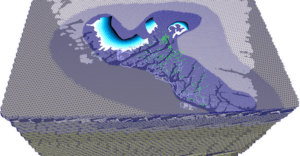
PROCEEDINGS OF THE NATIONAL ACADEMY OF SCIENCES—Rising sea levels and coastal flooding contributed to the abandonment of Viking settlements in Greenland, according to a study. Vikings occupied Greenland from around 985 CE until they abandoned their settlements around the middle of the 15th century. However, the factors that drove the abandonment of Greenland are unclear. Marisa Borreggine and colleagues used published geomorphological and paleoclimate data to model ice sheet growth and sea-level rise in Greenland during the Viking occupation to explore the influence of coastal inundation on settlement abandonment. Viking occupation of Greenland coincided with the transition from the Medieval Warm Period, around 900–1250 CE, to the Little Ice Age, around 1250–1900 CE. During the Little Ice Age, the Greenland Ice Sheet advanced toward the ocean. Geophysical modeling suggested that crustal subsidence and the increasing gravitational attraction between the ocean and the growing ice sheet would have driven an estimated 3-meter rise in sea level near the ice margin and resulted in the shoreline retreating by hundreds of meters. Archaeological evidence suggested that many Viking sites in Greenland were near the shorelines of glacially carved fjords, rendering them particularly vulnerable to sea-level rise. According to the authors, local sea-level rise was a previously overlooked yet major contributor to the Viking abandonment of Greenland.
_________________________________

Simulated seas level in Southern Greenland showing ice (blue to white gradient), Viking sites (green dots), and areas of flooding (blue). Konstantin Latychev
_________________________________
Article Source: PNAS news release
*“Sea-level rise in Southwest Greenland as a contributor to Viking abandonment,” by Marisa Borreggine et al., Proceedings of the National Academy of Sciences, 17-Apr-2023. 10.1073/pnas.2209615120
Advertisement
______________________________

Don’t miss out on this unforgettable evening as Dr. Hawass reveals the most closely guarded secrets of ancient Egypt and presents his groundbreaking new discoveries and latest research live on stage. As the man behind all major discoveries in Egypt over the last few decades and director of several ongoing archaeological projects, Dr. Hawass may yet surprise you with unexpected revelations that will make news across the world.
_________________________________




